Fostering Resilient Communities Through the Interaction of Heritage, Policy, and Participation: Insights from a Lithuanian Case Study
Abstract
1. Introduction
- -
- Literature review, focusing on potentials and barriers to social resilience in neighborhoods, the built environment and heritage aspects for local identity, community empowerment tools, and aspects on strengthening social resilience in urban neighborhoods.
- -
- Questionnaire survey study, focusing on social, environmental, heritage, economical, and resilience aspects of the urban neighborhood.
- -
- Proposed steps and actions. It is a theoretical conceptualization and formulation of the suggested directions of steps/actions for solving identified issues related to the social resilience of communities in urban neighborhoods.
- How do adaptive policies, participatory governance, and heritage conservation initiatives interact to enhance community resilience in urban settings?
- What roles do heritage elements play in strengthening community identity and social cohesion within urban neighborhoods?
- What are the barriers and facilitators to effective community participation in urban resilience initiatives?
- Integration of cultural heritage: while individual studies have focused on the role of heritage in urban resilience, there is a lack of comprehensive research integrating heritage with modern urban policy and community participation.
- Participatory governance: existing research often overlooks how participatory governance can be effectively implemented to enhance community resilience, particularly in diverse urban settings.
- Socioeconomic inequalities: there is a need to explore how adaptive urban policies can address socioeconomic inequalities within the framework of urban resilience.
2. Methodology
- Outline of theoretical frameworks
- Literature review: an extensive review of the existing literature to map the current knowledge landscape, identify gaps, and define the scope of how heritage and governance contribute to urban resilience.
- Empirical research design through a quantitative survey: Distributed among residents to assess perceptions of community identity, engagement in governance, and attitudes towards urban resilience initiatives, Lithuania was selected as a case study due to its unique urban development trajectory, European integration, and increasing attention to heritage-led planning. The country’s evolving planning and participation systems offer a valuable lens through which to examine tensions and synergies between policy, identity, and grassroots engagement.
2.1. Literature Review
- Potentials and barriers to social resilience in neighborhoods.
- The built environment and heritage aspects for local identity and civic engagement.
- Community empowerment tools.
- Strengthening social resilience in urban neighborhoods.
2.2. Questionaries’ Survey
2.3. Data Analysis
- Participants must be residents of the urban neighborhoods under study for at least one year to ensure that they have sufficient exposure to local dynamics.
- Participants must be aged 18 and above.
- Studies included in the literature review must be peer-reviewed articles published within the last 20 years, ensuring current relevance and scientific rigor.
- Studies must explicitly address at least one of the following: urban resilience, cultural heritage, or participatory governance.
- Studies or data older than 20 years, unless they are seminal works in the field.
- Non-English language sources, unless significant and pertinent information is available and translatable.
- Participants under the age of 18 or those who have lived in the area for less than one year, to maintain a focused and experienced respondent base.
- Studies that focus solely on rural resilience without applicability to urban contexts.
3. Literature Review
3.1. Potentials and Barriers to Social Resilience in Neighborhoods
3.2. The Built Environment and Heritage Aspects for Local Identity and Civic Engagement
3.3. Community Empowerment Tools
3.4. Strengthening Social Resilience in Urban Neighborhoods
4. Questionaries’ Survey Results
4.1. Profiles of the Respondents
4.2. The Built Environment and Heritage Aspects for Local Identity and Civic Engagement
- Parks, which were referenced 10 times.
- Buildings, which were referenced 6 times.
- Wooden architecture, which were referenced 3 times.
- Sculptures, which were referenced 3 times.
- Heritage, which were referenced 3 times.
- Fortresses, which were referenced 3 times.
4.3. Community Empowerment Tools
4.4. Strengthening Social Resilience in Urban Neighborhoods
5. Discussion
- (1)
- Adaptive policy frameworks and their ability to support long-term resilience;
- (2)
- Participatory governance tools and the extent to which they enable meaningful civic engagement;
- (3)
- Community identity and heritage values as foundations for localized resilience.
5.1. Potentials and Barriers to Social Resilience in Neighborhoods
5.2. Community Empowerment Tools
5.3. The Built Environment and Heritage Aspects for Local Identity and Civic Engagement
5.4. Strengthening Social Resilience in Urban Neighborhoods
6. Conclusions
- Adaptive urban policies: It is crucial to have adaptable urban policies that react quickly to crises like economic downturns and climate-related calamities. These regulations lessen social and environmental stresses and promote sustainable urban growth when paired with investments in resilient infrastructure, such as multipurpose public areas and green infrastructure. Survey responses emphasized the need for improved urban planning strategies to address accessibility gaps and enhance community satisfaction.
- Participatory governance and civic engagement: Mechanisms enabling resident involvement in decision-making processes are indispensable for inclusive and effective urban governance. While participatory frameworks are theoretically robust, survey findings reveal limited engagement opportunities, with only 16.7% of respondents actively participating in neighborhood planning activities. Addressing these gaps is critical to enhancing civic ownership and responsibility.
- Equitable urban planning: Tackling socioeconomic inequalities through equitable access to resources, housing, and services is vital for fostering resilience. Survey participants advocated for inclusive decision-making processes and highlighted disparities in access to essential services, particularly green spaces and cultural heritage preservation initiatives.
- Collaboration and stakeholder engagement: Building partnerships among governments, community organizations, academic institutions, and the private sector fosters comprehensive approaches to urban resilience. Survey insights revealed a pressing need for stronger collaboration to effectively address residents’ concerns.
- Social capital and community networks: Trust, solidarity, and mutual aid among residents form the foundation of social resilience. Community initiatives, such as events, local associations, and social gatherings, strengthen bonds and foster cohesion. Survey participants expressed the value of initiatives that promote mutual support within neighborhoods.
- Education and awareness: Empowering residents with knowledge and skills is critical for resilience building. Educational programs tailored to local needs allow individuals to actively contribute to their community’s preparedness and adaptability. Survey responses underscored the demand for such initiatives to enhance local resilience efforts.
- Economic development and heritage conservation: Supporting local economic development through community-driven initiatives, such as cooperatives and heritage-related activities, enhances financial stability and reduces vulnerability to economic shocks. Survey findings highlight the significant role of cultural heritage in fostering neighborhood identity and civic pride.
Author Contributions
Funding
Institutional Review Board Statement
Informed Consent Statement
Data Availability Statement
Conflicts of Interest
References
- Meerow, S.; Newell, J.P.; Stults, M. Defining Urban Resilience: A Review. Landsc. Urban Plan. 2016, 147, 38–49. [Google Scholar] [CrossRef]
- Keck, M.; Sakdapolrak, P. What is social resilience? Lessons learned and ways forward. Erdkunde 2013, 67, 5–19. [Google Scholar] [CrossRef]
- Adger, W.N. Social and Ecological Resilience: Are They Related? Prog. Hum. Geogr. 2000, 24, 347–364. [Google Scholar] [CrossRef]
- Armitage, D.; Béné, C.; Charles, A.T.; Johnson, D.; Allison, E.H. The Interplay of Well-Being and Resilience in Applying a Social-Ecological Perspective. Ecol. Soc. 2012, 17, 15. [Google Scholar] [CrossRef]
- Folke, C.; Carpenter, S.R.; Walker, B.; Scheffer, M.; Chapin, T.; Rockström, J. Resilience thinking: Integrating resilience, adaptability, and transformability. Ecol. Soc. 2010, 15, 20. [Google Scholar] [CrossRef]
- Harrison, R. Heritage: Critical Approaches; Routledge: London, UK, 2013. [Google Scholar]
- Arnstein, S.R. A ladder of citizen participation. J. Am. Inst. Plann. 1969, 35, 216–224. [Google Scholar] [CrossRef]
- Innes, J.E.; Booher, D.E. Planning with Complexity: An Introduction to Collaborative Rationality for Public Policy; Routledge: London, UK, 2010. [Google Scholar]
- Manzo, L.C.; Perkins, D.D. Finding common ground: The importance of place attachment to community participation. J. Plan. Lit. 2006, 20, 335–350. [Google Scholar] [CrossRef]
- Duxbury, N.; Hosagrahar, J.; Pascual, J. Why must culture be at the heart of sustainable urban development? In Agenda 21 for Culture; United Cities and Local Governments (UCLG): Barcelona, Spain, 2016. [Google Scholar]
- Berkes, F.; Ross, H. Community resilience: Toward an integrated approach. Soc. Nat. Resour. 2013, 26, 5–20. [Google Scholar] [CrossRef]
- Wilson, G.A. Community Resilience and Environmental Transitions; Routledge: London, UK, 2012. [Google Scholar]
- Frantzeskaki, N.; Kabisch, N.; McPhearson, T. Advancing urban environmental governance: Understanding theories, practices and processes shaping urban sustainability and resilience. Environ. Sci. Policy 2016, 62, 1–6. [Google Scholar] [CrossRef]
- MacKinnon, D.; Derickson, K.D. From resilience to resourcefulness: A critique of resilience policy and activism. Prog. Hum. Geogr. 2013, 37, 253–270. [Google Scholar] [CrossRef]
- Brown, K.; Westaway, E. Agency, capacity, and resilience to environmental change: Lessons from human development, well-being, and disasters. Annu. Rev. Environ. Resour. 2011, 36, 321–342. [Google Scholar] [CrossRef]
- Braun, V.; Clarke, V. Using thematic analysis in psychology. Qual. Res. Psychol. 2006, 3, 77–101. [Google Scholar] [CrossRef]
- Barr, S.; Devine-Wright, P. Resilient communities: Sustainabilities in transition. Local Environ. 2012, 17, 525–532. [Google Scholar] [CrossRef]
- Bratman, G.N.; Anderson, C.B.; Berman, M.G.; Cochran, B.; De Vries, S.; Flanders, J.; Daily, G.C. Nature and mental health: An ecosystem service perspective. Sci. Adv. 2019, 5, eaax0903. [Google Scholar] [CrossRef]
- Larimian, T.; Sadeghi, A.; Palaiologou, G.; Schmidt, R., III. Neighbourhood social resilience (NSR): Definition, conceptualisation, and measurement scale development. Sustainability 2020, 12, 6363. [Google Scholar] [CrossRef]
- Anthony, B., Jr. The role of community engagement in urban innovation towards the co-creation of smart sustainable cities. J. Knowl. Econ. 2024, 15, 1592–1624. [Google Scholar] [CrossRef]
- Zaleckis, K.; Vitkuviene, J.; Jankauskaite-Jureviciene, L.; Grazuleviciute-Vileniske, I.; Karvelyte-Balbieriene, V. Community Involvement in Place-Making: Present Map Methodology. Archit. Urban Plan. 2023, 19, 29–37. [Google Scholar] [CrossRef]
- Zaleckis, K.; Vitkuviene, J.; Jankauskaite-Jureviciene, L.; Grazuleviciute-Vileniske, I. Application of Urban Theories in Developing Participatory Planning Tools. Archit. Urban Plan. 2024, 20, 52–64. [Google Scholar] [CrossRef]
- Van Zandt, S.; Peacock, W.G.; Henry, D.W.; Grover, H.; Highfield, W.E.; Brody, S.D. Mapping social vulnerability to enhance housing and neighborhood resilience. Hous. Policy Debate 2012, 22, 29–55. [Google Scholar] [CrossRef]
- Vitkuvienė, J.; Gražulevičiūtė-Vileniškė, I.; Zaleckis, K.; Tranavičiūtė, B. Serious game and serious play concepts in the content analysis of urban spaces. Archit. Urban Plan. 2019, 15, 30–37. [Google Scholar] [CrossRef]
- Lozano, R. Envisioning sustainability three-dimensionally. J. Clean. Prod. 2008, 16, 1838–1846. [Google Scholar] [CrossRef]
- Dumitru, A.; Wendling, L. Evaluating the Impact of Nature-Based Solutions: A Handbook for Practitioners; European Commission EC: Brussels, Belgium, 2021. [Google Scholar]
- Bessière, J. Local development and heritage: Traditional food and cuisine as tourist attractions in rural areas. Sociol. Rural. 1998, 38, 21–34. [Google Scholar] [CrossRef]
- Beriatos, E.; Gospodini, A. ‘Glocalising’ urban landscapes: Athens and the 2004 Olympics. In Dialogues in Urban and Regional Planning; Routledge: London, UK, 2006; pp. 69–102. [Google Scholar]
- Gravagnuolo, A.; Micheletti, S.; Bosone, M. A participatory approach for “circular” adaptive reuse of cultural heritage. Building a heritage community in Salerno, Italy. Sustainability 2021, 13, 4812. [Google Scholar] [CrossRef]
- Tweed, C.; Sutherland, M. Built cultural heritage and sustainable urban development. Landsc. Urban Plan. 2007, 83, 62–69. [Google Scholar] [CrossRef]
- Murzyn-Kupisz, M.; Działek, J. Cultural heritage in building and enhancing social capital. J. Cult. Herit. Manag. Sustain. Dev. 2013, 3, 35–54. [Google Scholar] [CrossRef]
- Santander, A.A.; Garai-Olaun, A.A.; De la Fuente Arana, A. Historic urban landscapes: A review on trends and methodologies in the urban context of the 21st century. Sustainability 2018, 10, 2603. [Google Scholar] [CrossRef]
- Grazuleviciute-Vileniske, I.; Seduikyte, L.; Daugelaite, A.; Rudokas, K. Links between heritage building, historic urban landscape and sustainable development: Systematic approach. Landsc. Archit. Art 2020, 17, 17. [Google Scholar] [CrossRef]
- Vecco, M. Genius loci as a meta-concept. J. Cult. Herit. 2020, 41, 225–231. [Google Scholar] [CrossRef]
- Seduikyte, L.; Grazuleviciute-Vileniske, I.; Kvasova, O.; Strasinskaite, E. Knowledge transfer in sustainable management of heritage buildings. Case of Lithuania and Cyprus. Sustain. Cities Soc. 2018, 40, 66–74. [Google Scholar] [CrossRef]
- Fiorentino, S.; Vandini, M. Resilience and Sustainable Territorial Development: Safeguarding Cultural Heritage at Risk for Promoting Awareness and Cohesiveness Among Next-Generation Society. Sustainability 2024, 16, 10968. [Google Scholar] [CrossRef]
- Lansiwi, M.A.; Studyanto, A.B.; Gymnastiar, I.A.; Amin, F. Cultural heritage preservation through community engagement a new paradigm for social sustainability. Indones. J. Stud. Humanit. Soc. Sci. Educ. 2024, 1, 50–59. [Google Scholar] [CrossRef]
- Ripp, M.; Egusquiza, A.; Lückerath, D. Urban Heritage Resilience: An Integrated and Operationable Definition from the SHELTER and ARCH Projects. Land 2024, 13, 2052. [Google Scholar] [CrossRef]
- Rypkema, D. Culture, historic preservation and economic development in the 21st century. In Proceedings of the Leadership Conference on Conservancy and Development, Kunming, China; Lijiang, China, 12–18 September 1999; Available online: http://www.columbia.edu/cu/china/DVRP.html (accessed on 20 October 2024).
- Sager, T. Neo-liberal urban planning policies: A literature survey 1990–2010. Prog. Plan. 2011, 76, 147–199. [Google Scholar] [CrossRef]
- Brenner, N.; Marcuse, P.; Mayer, M. Cities for people, not for profit. City 2009, 13, 176–184. [Google Scholar] [CrossRef]
- Reed, M.S. Stakeholder participation for environmental management: A literature review. Biol. Conserv. 2008, 141, 2417–2431. [Google Scholar] [CrossRef]
- Li, Y.; Hunter, C. Community involvement for sustainable heritage tourism: A conceptual model. J. Cult. Herit. Manag. Sustain. Dev. 2015, 5, 248–262. [Google Scholar] [CrossRef]
- Laverack, G.; Wallerstein, N. Measuring community empowerment: A fresh look at organizational domains. Health Promot. Int. 2001, 16, 179–185. [Google Scholar] [CrossRef]
- Ahmad, M.S.; Abu Talib, N.B. Empowering local communities: Decentralization, empowerment, and community-driven development. Qual. Quant. 2015, 49, 827–838. [Google Scholar] [CrossRef]
- Temeljotov Salaj, A.; Gohari, S.; Senior, C.; Xue, Y.; Lindkvist, C. An interactive tool for citizens’ involvement in sustainable regeneration. Facilities 2020, 38, 859–870. [Google Scholar] [CrossRef]
- Panek, J.; Vlok, C. Participatory mapping as a tool for community empowerment—A case study of community engagement in Koffiekraal, South Africa. In Proceedings of the 26th International Cartographic Conference, Dresden, Germany, 25–30 August 2013; p. 26. [Google Scholar]
- Chin, I.; Joerin, J.; Schubert, R. Strengthening Social Resilience—The Importance of Trust; The Future Resilient Systems Trust Report; Singapore-ETH Centre: Singapore, 2023. [Google Scholar]
- Schell, C.J.; Dyson, K.; Fuentes, T.L.; Des Roches, S.; Harris, N.C.; Miller, D.S.; Lambert, M.R. The ecological and evolutionary consequences of systemic racism in urban environments. Science 2020, 369, 4497. [Google Scholar] [CrossRef]
- Ribeiro, P.J.G.; Gonçalves, L.A.P.J. Urban resilience: A conceptual framework. Sustain. Cities Soc. 2019, 50, 101625. [Google Scholar] [CrossRef]
- Mahadevan, J. Change and Learning, Tacit Knowledge Management and Virtual Team Innovativeness under BANI Conditions: The Role of Leadership, Organization, and Technology. In Virtual Team Collaboration: A Guide for Individual Team Members; Springer Fachmedien Wiesbaden: Wiesbaden, Germany, 2024; pp. 255–287. [Google Scholar] [CrossRef]
- Armawi, A.; Limbongan, S.A. The local-wisdom-based social capital for strengthening social resilience during the COVID-19 pandemic. Masy. Kebud. Polit. 2022, 35, 4. [Google Scholar] [CrossRef]
- Aldrich, D.P. The importance of social capital in building community resilience. In Rethinking Resilience, Adaptation and Transformation in a Time of Change; Boyd, E., Ensor, J., Eds.; Springer: Cham, Switzerland, 2017; pp. 357–364. [Google Scholar]
- Leap, B.; Thompson, D. Social solidarity, collective identity, resilient communities: Two case studies from the rural US and Uruguay. Soc. Sci. 2018, 7, 250. [Google Scholar] [CrossRef]
- Carabine, E.; Wilkinson, E. How can local governance systems strengthen community resilience? A social-ecological systems approach. Politics Gov. 2016, 4, 62–73. [Google Scholar] [CrossRef]
- Morrow, B.H. Community Resilience: A Social Justice Perspective; CARRI Research Report 4; Community and Regional Resilience Initiative: Oak Ridge, TN, USA, 2008. [Google Scholar]
- Graham, L.; Debucquoy, W.; Anguelovski, I. The influence of urban development dynamics on community resilience practice in New York City after Superstorm Sandy: Experiences from the Lower East Side and the Rockaways. Glob. Environ. Chang. 2016, 40, 112–124. [Google Scholar] [CrossRef]
- Soja, E. The city and spatial justice. Justice Spatiale/Spat. Justice 2009, 1, 1–5. [Google Scholar]
- Jankauskaitė-Jurevičienė, L. Assumptions of the concept of spatial justice in the theory and practice of urban planning processes. Archit. Urban Plan. 2022, 18, 111–119. [Google Scholar] [CrossRef]
- Beatley, T. Biophilic urbanism: Inviting nature back to our communities and into our lives. Wm. Mary Environ. Law Policy Rev. 2009, 34, 209. [Google Scholar]
- Vargas, C.; Whelan, J.; Brimblecombe, J.; Allender, S. Co-creation, co-design and co-production for public health: A perspective on definitions and distinctions. Public Health Res. Pract. 2022, 32, e3222211. [Google Scholar] [CrossRef]
- Rizzi, P.; Porębska, A. Towards a revised framework for participatory planning in the context of risk. Sustainability 2020, 12, 5539. [Google Scholar] [CrossRef]
- Sintomer, Y.; Herzberg, C.; Röcke, A. Participatory budgeting in Europe: Potentials and challenges. Int. J. Urban Reg. Res. 2008, 32, 164–178. [Google Scholar] [CrossRef]
- Clark, J.; Friedman, B. Community Advisory Boards: What works and what doesn’t (Lessons from a National Study). Am. J. Crim. Law 2020, 47, 159. [Google Scholar]
- Rypkema, D. Cultural heritage and sustainable economic and social development. In Proceedings of the European Cultural Heritage Forum, Cultural Heritage Counts for Europe, Europa Nostra, Brussels, Belgium, 7 December 2005. [Google Scholar]
- Dogan, H.A. Assessment of the perception of cultural heritage as an adaptive re-use and sustainable development strategy: Case study of Kaunas, Lithuania. J. Cult. Herit. Manag. Sustain. Dev. 2019, 9, 430–443. [Google Scholar] [CrossRef]
- Della Spina, L. Multidimensional assessment for “culture-led” and “community-driven” urban regeneration as driver for trigger economic vitality in urban historic centers. Sustainability 2019, 11, 7237. [Google Scholar] [CrossRef]
- Koroļova, A.; Treija, S. Urban gardening as a multifunctional tool to increase social sustainability in the city. Archit. Urban Plan. 2018, 14, 91–95. [Google Scholar] [CrossRef]
- Tousi, E.; Karadoulama, K.; Papaioannou, I.; Patsea, A.; Skrepi, A.; Spentza, E.; Zafeiropoulos, G. Issues of Urban Conservation and Collective Memory. The Case of the Asia Minor Post-Refugee Urban Neighbourhood Germanika at Nikea, Piraeus, Greece. J. Sustain. Archit. Civ. Eng. 2023, 33, 30–44. [Google Scholar] [CrossRef]
- Daugėlaitė, A. Psychological Acceptance of Sustainable Architecture in Lithuania: A Qualitative Study. J. Sustain. Archit. Civ. Eng. 2023, 32, 41–57. [Google Scholar] [CrossRef]
- Mela, A.; Tousi, E. Safe and Inclusive Urban Public Spaces: A Gendered Perspective. The Case of Attica’s Public Spaces During the COVID-19 Pandemic in Greece. J. Sustain. Archit. Civ. Eng. 2023, 33, 5–14. [Google Scholar] [CrossRef]
- Vilkauskaitė, A.; Mlinkauskienė, A. Opportunities for renovation of Mid-20th century buildings in a protected environment: The example of the writers’ creative house in Nida. J. Sustain. Archit. Civ. Eng. 2024, 35, 5–14. [Google Scholar] [CrossRef]
- Zaleckis, K.; Matijošaitienė, I. Space syntax analysis of Kaunas: Some methodological aspects. J. Sustain. Archit. Civ. Eng. 2013, 1, 29–34. [Google Scholar] [CrossRef]
- Zaleckis, K.; Jankauskaite-Jureviciene, L.; Vitkuviene, J.; Grazuleviciute-Vileniske, I.; Karvelyte-Balbieriene, V. Integration of Collective Knowledge into Simulative Urban Modeling. In Annual Conference of the European Association for Architectural Education, Madrid, Spain, 31 August–2 September 2022; Springer Nature: Cham, Switzerland, 2022; pp. 214–230. [Google Scholar]

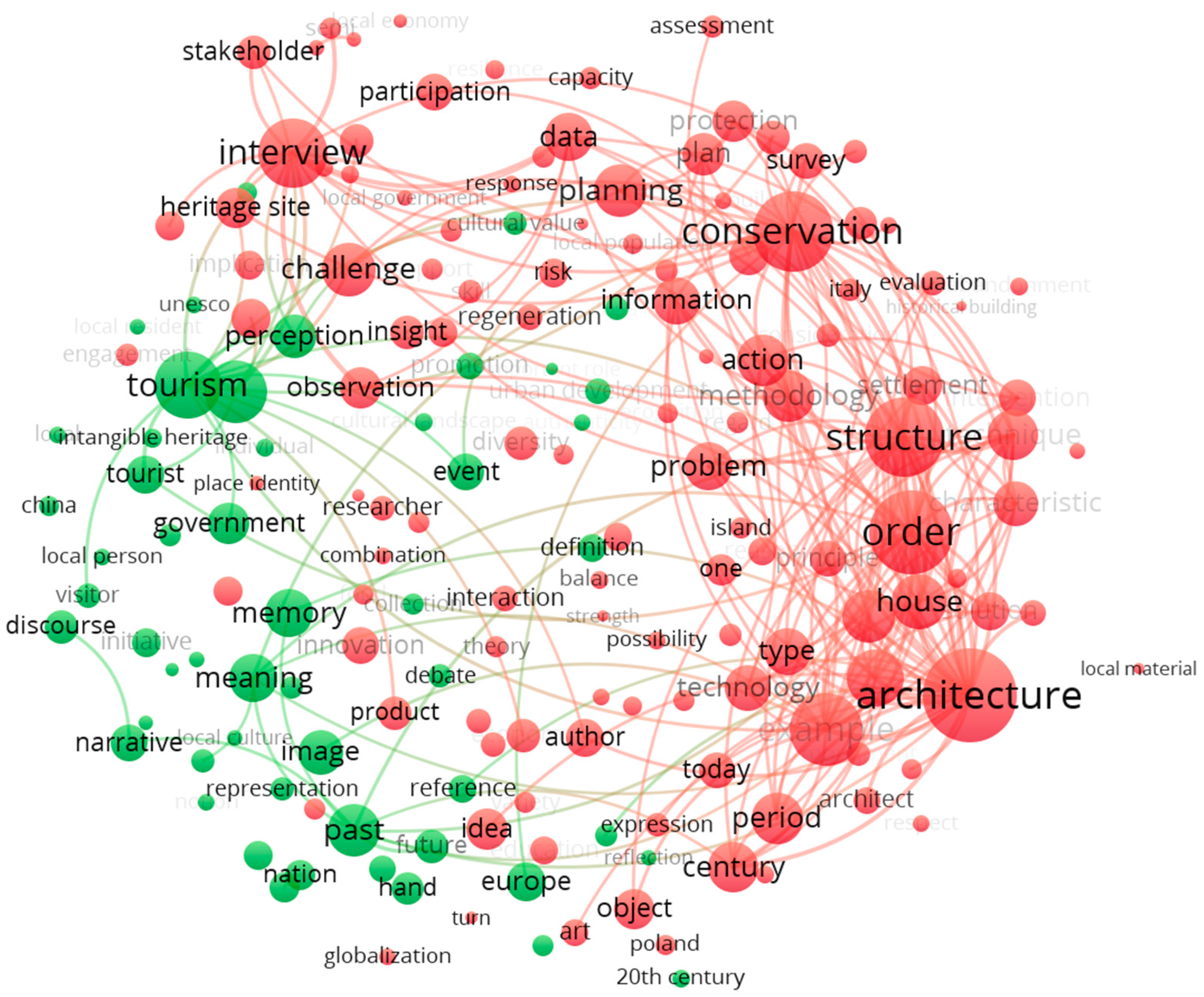

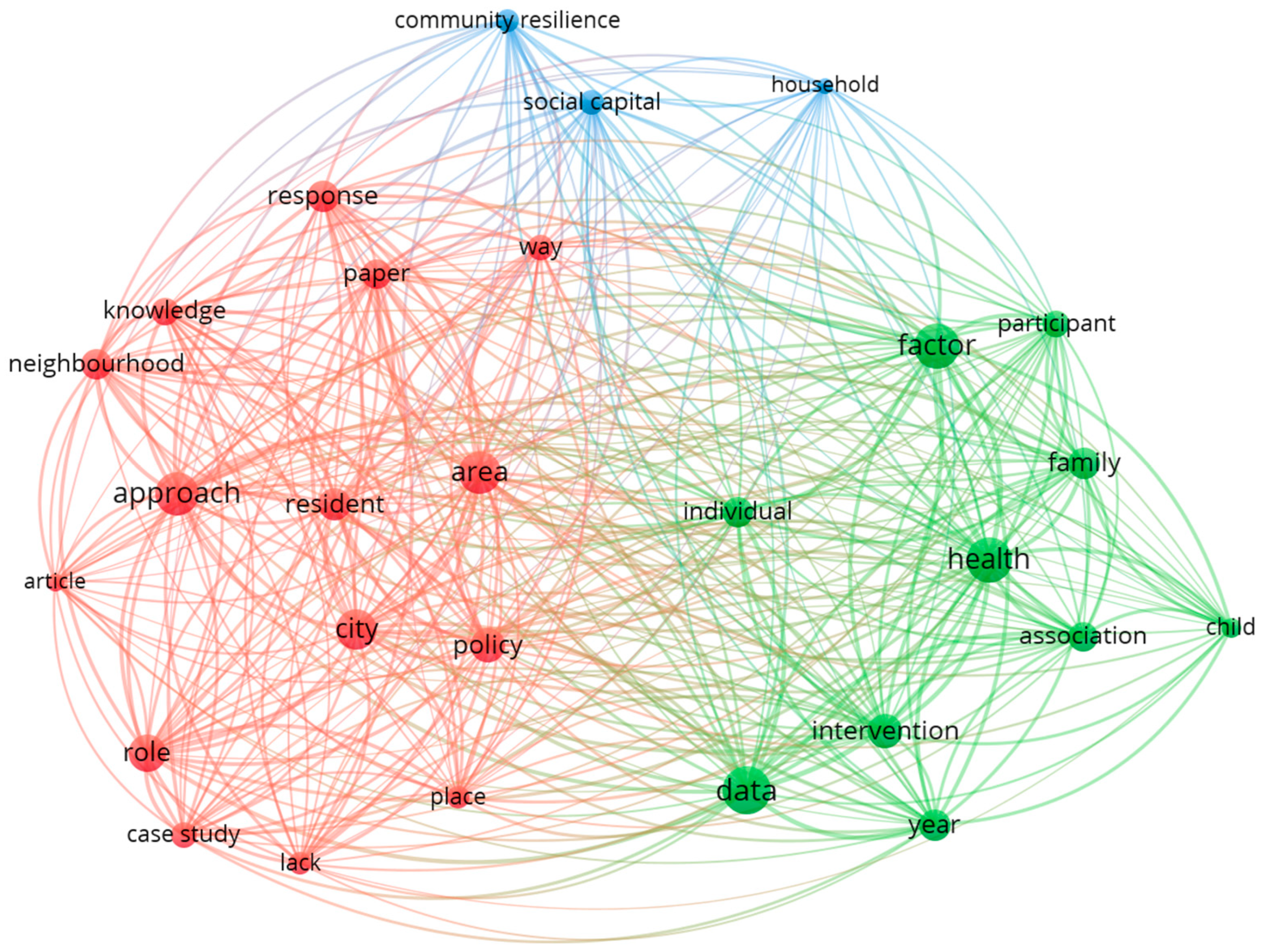
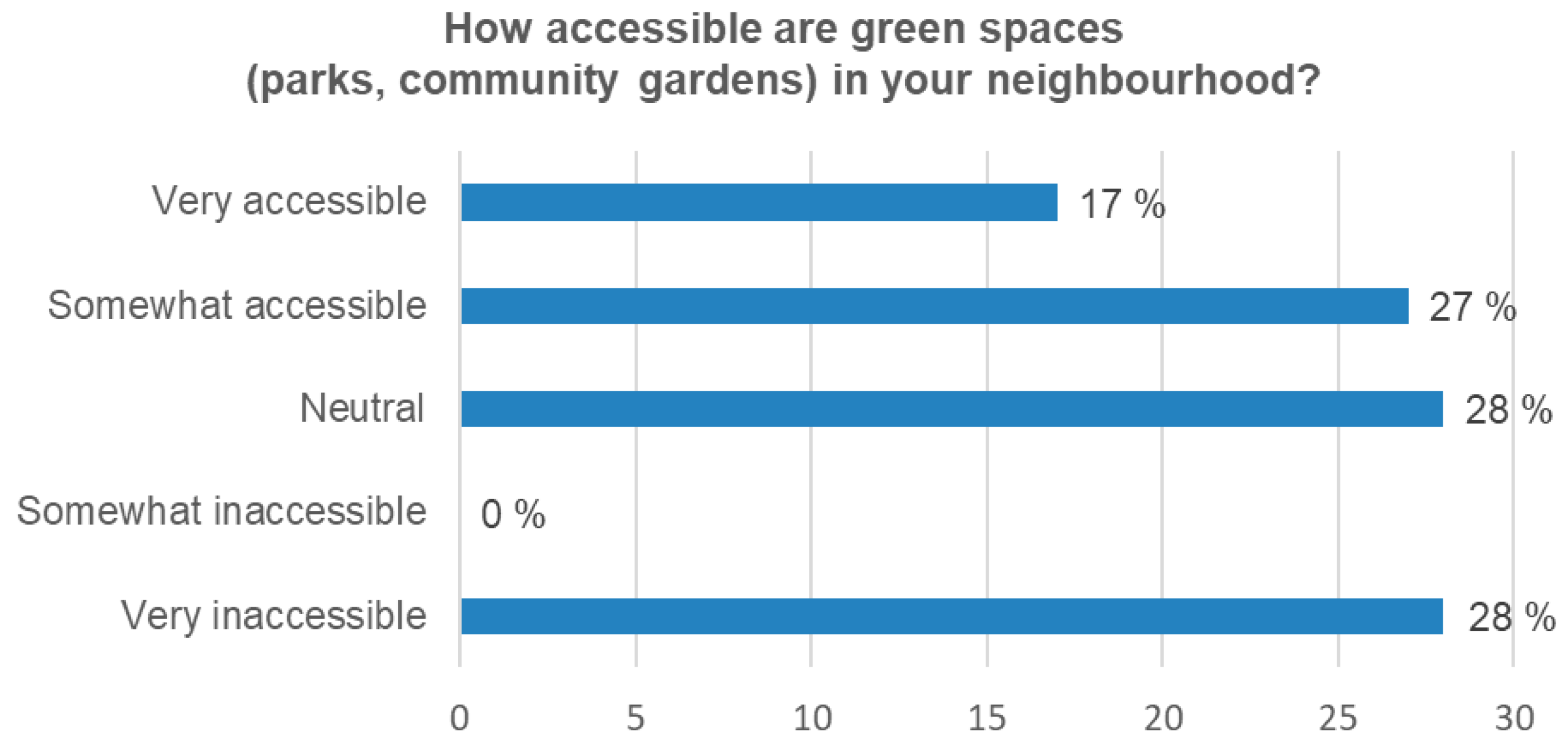
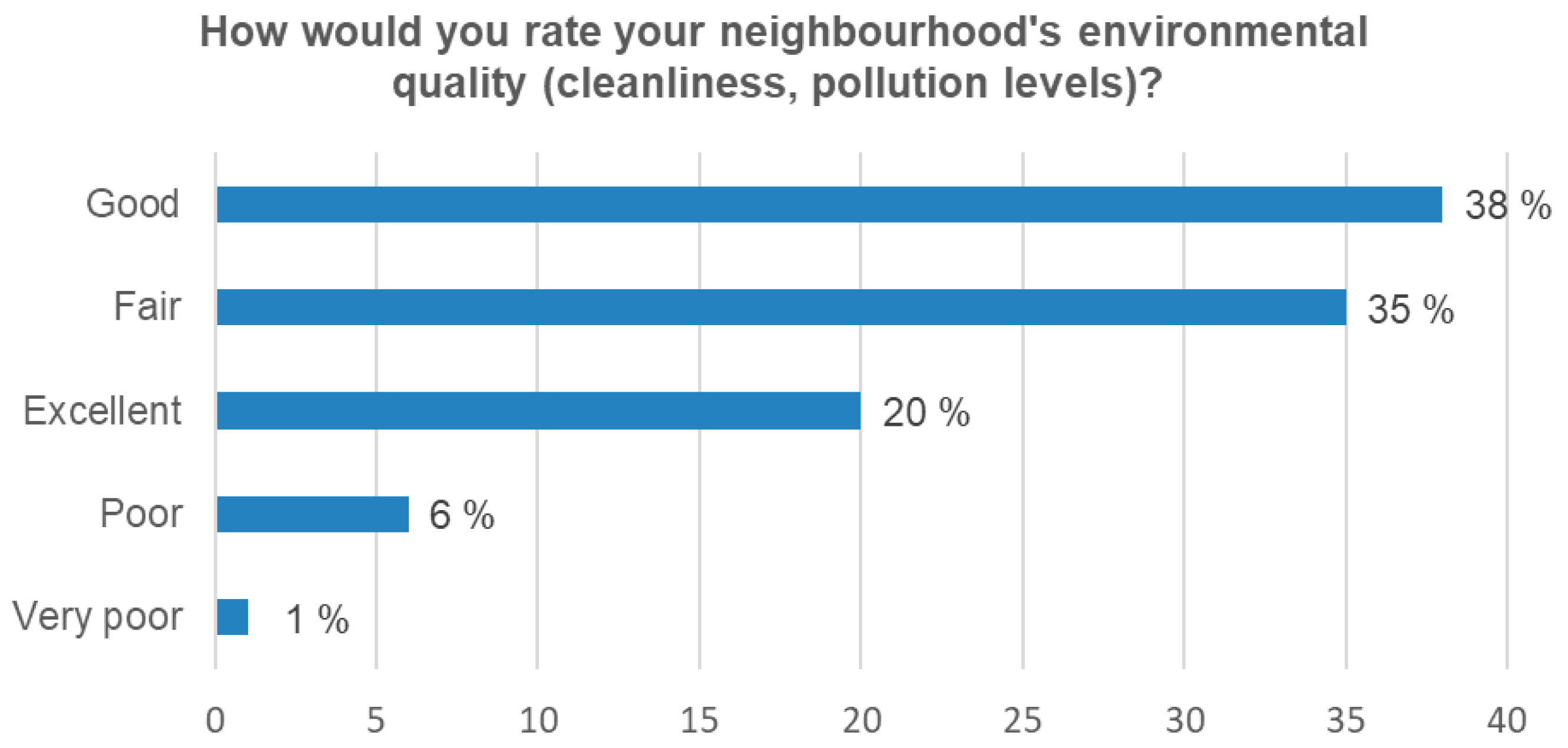
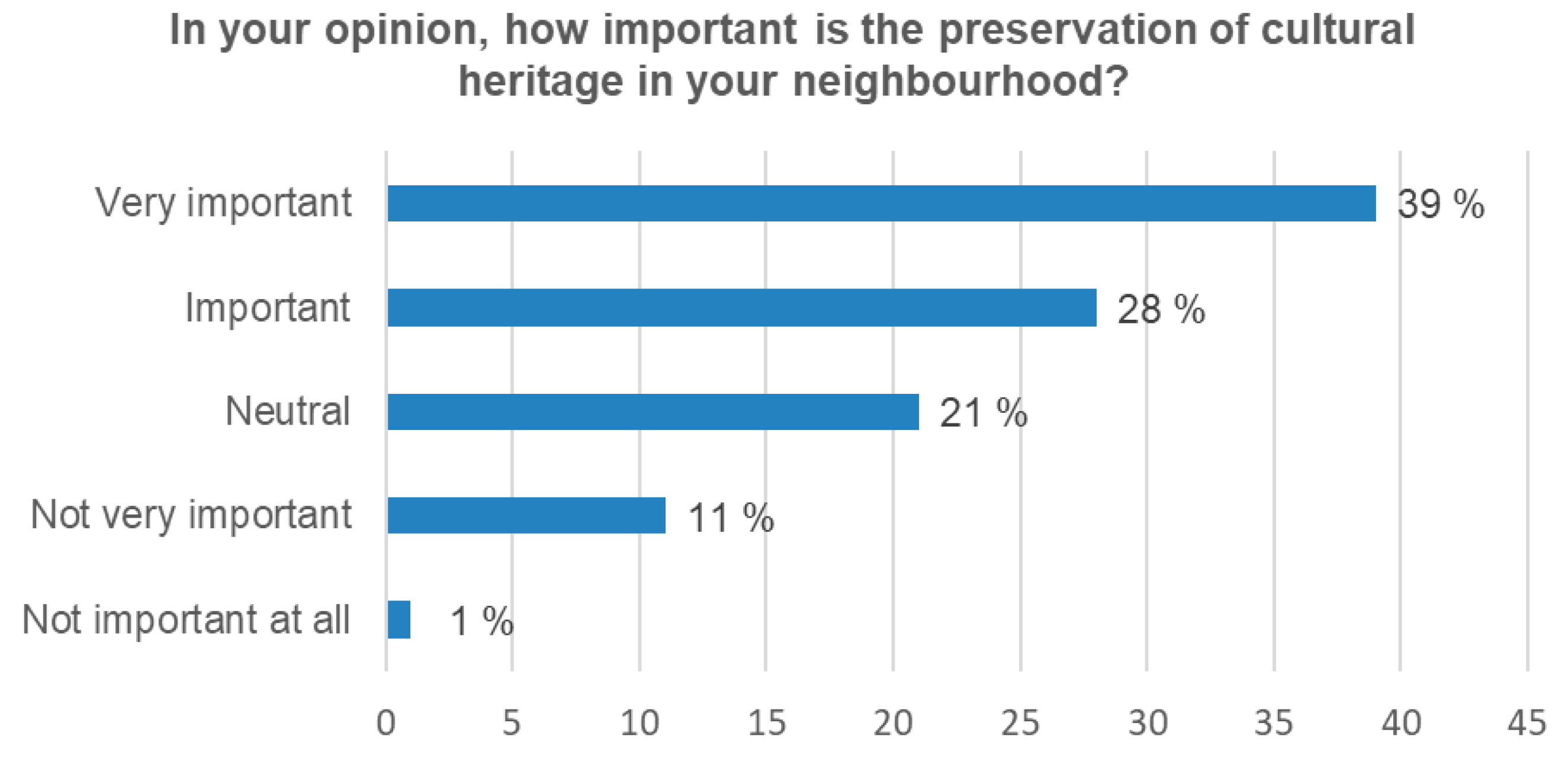

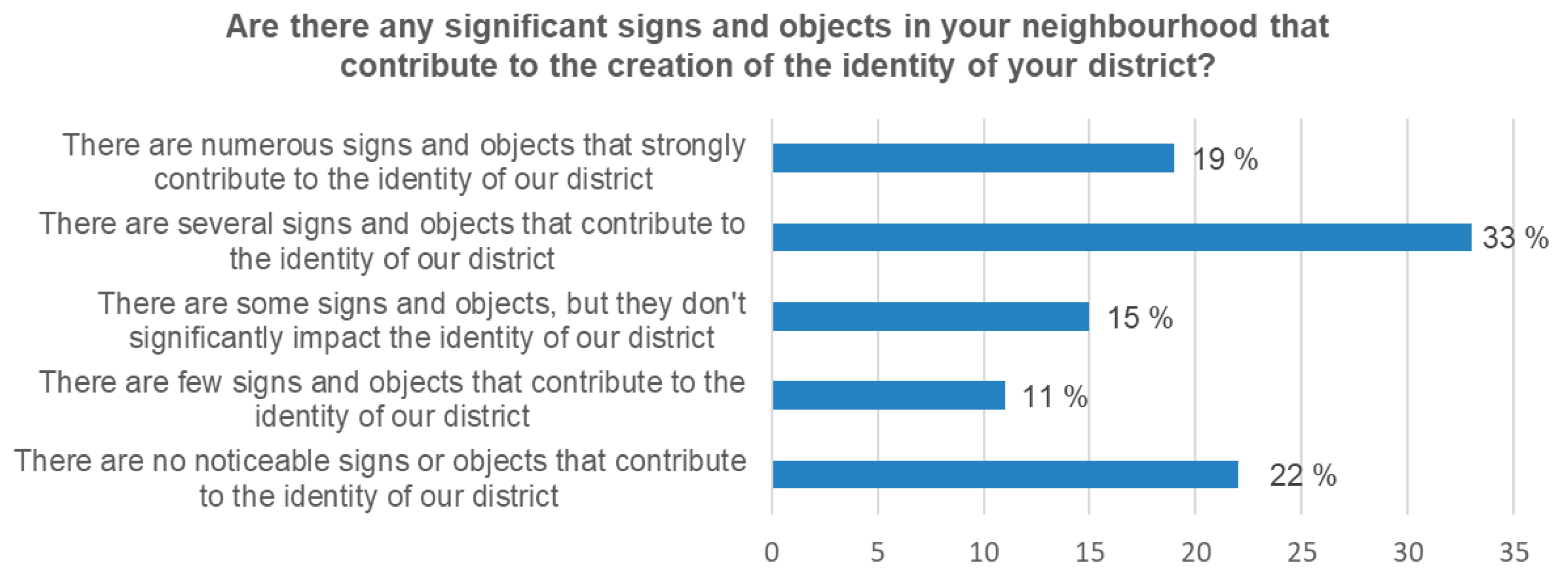
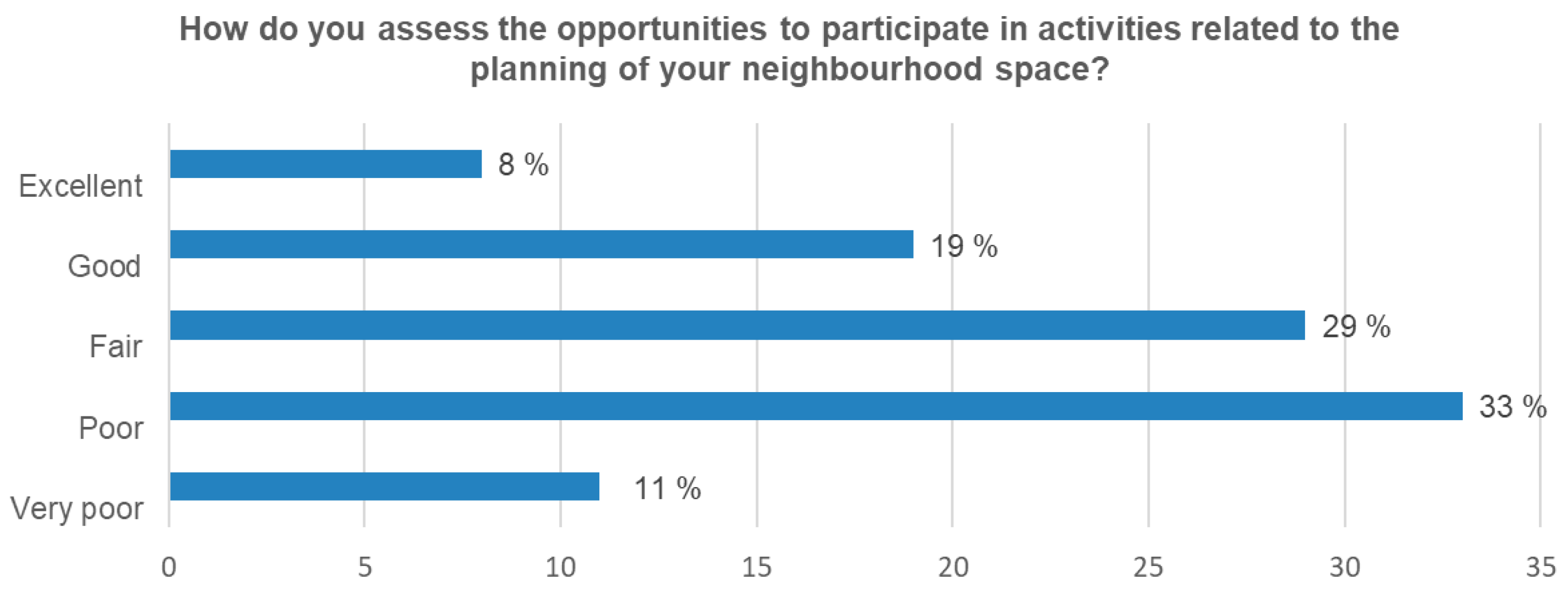


| Age | Gender | Education | |||||||||
|---|---|---|---|---|---|---|---|---|---|---|---|
| 18–24 | 25–34 | 35–44 | Female | Secondary | Bachelor’s | ||||||
| 34.4% | 13.3% | 14.4% | 65.6% | 32.2% | 8.9% | ||||||
| 45–54 | 55–64 | 65 and above | Male | Master’s | Doctorate (Ph.D) | ||||||
| 27.8% | 6.8% | 3.3% | 34.4% | 32.2% | 26.7% | ||||||
| Current professional role | |||||||||||
| Student | Community member | Developer/investor | |||||||||
| 40% | 23.3% | 4.4% | |||||||||
| Practicing architect or urban planner | NGO active in environmental/ urban development | Other | |||||||||
| 15.6% | 1.1% | 15.6% | |||||||||
| Type of settlement where respondent lives | Type of residential unit | ||||||||||
| City | Suburb | Village | Owned house | Owned flat | Rented flat | Prefer not to answer | |||||
| 72.2% | 15.6% | 12.2% | 56.7% | 28.9% | 12.2% | 2.2% | |||||
| Answers | Municipality | Business Sector | Civil Society |
|---|---|---|---|
| Strongly agree | 45% | 16% | 9% |
| Agree | 29% | 28% | 31% |
| Neutral | 23% | 43% | 47% |
| Disagree | 2% | 11% | 8% |
| Strongly disagree | 1% | 2% | 5% |
| Answers | Municipality | Business Sector | Civil Society |
|---|---|---|---|
| Strongly agree | 12 | 3 | 9 |
| Agree | 38 | 21 | 49 |
| Neutral | 39 | 53 | 32 |
| Disagree | 9 | 17 | 8 |
| Strongly disagree | 2 | 6 | 2 |
Disclaimer/Publisher’s Note: The statements, opinions and data contained in all publications are solely those of the individual author(s) and contributor(s) and not of MDPI and/or the editor(s). MDPI and/or the editor(s) disclaim responsibility for any injury to people or property resulting from any ideas, methods, instructions or products referred to in the content. |
© 2025 by the authors. Licensee MDPI, Basel, Switzerland. This article is an open access article distributed under the terms and conditions of the Creative Commons Attribution (CC BY) license (https://creativecommons.org/licenses/by/4.0/).
Share and Cite
Seduikyte, L.; Grazuleviciute-Vileniske, I.; Mlinkauskienė, A.; Januškienė, E. Fostering Resilient Communities Through the Interaction of Heritage, Policy, and Participation: Insights from a Lithuanian Case Study. Sustainability 2025, 17, 3883. https://doi.org/10.3390/su17093883
Seduikyte L, Grazuleviciute-Vileniske I, Mlinkauskienė A, Januškienė E. Fostering Resilient Communities Through the Interaction of Heritage, Policy, and Participation: Insights from a Lithuanian Case Study. Sustainability. 2025; 17(9):3883. https://doi.org/10.3390/su17093883
Chicago/Turabian StyleSeduikyte, Lina, Indre Grazuleviciute-Vileniske, Aušra Mlinkauskienė, and Eglė Januškienė. 2025. "Fostering Resilient Communities Through the Interaction of Heritage, Policy, and Participation: Insights from a Lithuanian Case Study" Sustainability 17, no. 9: 3883. https://doi.org/10.3390/su17093883
APA StyleSeduikyte, L., Grazuleviciute-Vileniske, I., Mlinkauskienė, A., & Januškienė, E. (2025). Fostering Resilient Communities Through the Interaction of Heritage, Policy, and Participation: Insights from a Lithuanian Case Study. Sustainability, 17(9), 3883. https://doi.org/10.3390/su17093883







